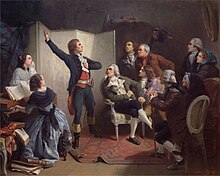
Most nation states have an anthem, defined as "a song, as of praise, devotion, or patriotism";[1] most anthems are either marches or hymns in style. A song or hymn can become a national anthem under the state's constitution, by a law enacted by its legislature, or simply by tradition.[2] A royal anthem is a patriotic song similar to a national anthem, but it specifically praises or prays for a monarch or royal dynasty. Such anthems are usually performed at public appearances by the monarch or during other events of royal importance.[3] Some states use their royal anthem as the national anthem, such as the state anthem of Jordan.
There are multiple claimants to the position of oldest national anthem.[4][5] Among the national anthems, the first to be composed was the Dutch national anthem, the "Wilhelmus", which was written between 1568 and 1572.[6] This has both Dutch and English language versions and is unusual in being an acrostic in both languages. The Japanese anthem, "Kimigayo", employs the oldest lyrics of any national anthem, taking its words from the "Kokin Wakashū", which was first published in 905, yet these words were not set to music until 1880.[7] The first anthem to be officially adopted as such was the Spanish anthem "La Marcha Real", in 1770; its origins remain unclear; it is suggested that it has 16th century Venetian origins, or even that it was composed by king Frederick the Great himself; it is also one of the few national anthems that has never had official lyrics.[8] Anthems became increasingly popular among European states in the 18th century.[9] For example, the British national anthem "God Save the King" was first performed in 1745.[10] The French anthem "La Marseillaise" was written half a century later in 1792, and adopted in 1795.[11]
National anthems are usually written in the most common language of the state, whether de facto or official. States with multiple national languages may offer several versions of their anthem. For instance, Switzerland's national anthem has different lyrics for each of the country's four official languages: French, German, Italian, and Romansh.[12] One of New Zealand's two national anthems is commonly sung with the first verse in Māori ("Aotearoa") and the second in English ("God Defend New Zealand"). The tune is the same but the lyrics have different meanings. South Africa's national anthem is unique in that it is two different songs put together with five of the country's eleven official languages being used, in which each language comprises a stanza.[13]
Denmark and New Zealand are two countries with two official national anthems of equal status. Denmark has two anthems, Der er et yndigt land ("There is a Lovely Country") and Kong Christian stod ved højen mast ("King Christian stood by the lofty mast"). Der er et yndigt land is considered the civil national anthem and is often played at civil and sports events. Kong Christian stod ved højen mast is both a royal and national anthem. New Zealand has two anthems, God Defend New Zealand and God Save the King. God Defend New Zealand was added in 1977 after a petition to Parliament and Queen Elizabeth II's approval. The two anthems are often sung together, with the first verse of God Defend New Zealand in Māori ("Aotearoa") and the second in English.
India has both a national anthem, Jana-gana-mana, and a national song, Vande Mataram. Jana-gana-mana was originally written in Bengali by Rabindranath Tagore in 1911 and adopted as the national anthem in 1950. Vande Mataram was composed in Sanskritised Bengali by Bankimchandra Chatterjee in the 1870s and inspired people during their fight for freedom.
- ^ "Anthem". Reference.com. Lexico Publishing Group. Retrieved 26 June 2008.
- ^ "National anthem". Encyclopædia Britannica. 2008.
- ^ "Royal anthem "God Save The Queen"". Department of Canadian Heritage. Archived from the original on 8 August 2008. Retrieved 17 April 2008.
- ^ "What are the world's oldest national anthems?". NationalAnthems.me. Archived from the original on 22 December 2011. Retrieved 14 August 2011.
- ^ "Oldest national anthems". Guinness World Records. Retrieved 5 May 2024.
- ^ "The Dutch Royal House". Dutch Royal House. Archived from the original on 10 February 2008. Retrieved 17 April 2008.
- ^ Japan Policy Research Institute JPRI Working Paper No. 79 Archived 2 October 2018 at the Wayback Machine. Published July 2001. Retrieved 7 July 2007
- ^ "Lost for words". The Economist. 26 July 2007. Retrieved 17 April 2008.
- ^ "'Bird's Nest' Ballads: Olympic National Anthems". NPR. 7 August 2008. Retrieved 2 October 2008.
- ^ "God Save the King". The Gentleman's Magazine. 15: 552. October 1745.
- ^ "La Marseillaise". Fordham University. Retrieved 17 April 2008.
- ^ "Facts and figures". Government of Switzerland. Archived from the original on 11 June 2008. Retrieved 17 April 2008.
- ^ Ash, Timothy Garton (17 January 2008). "There are great national anthems – now we need an international one". The Guardian. Retrieved 17 April 2008.